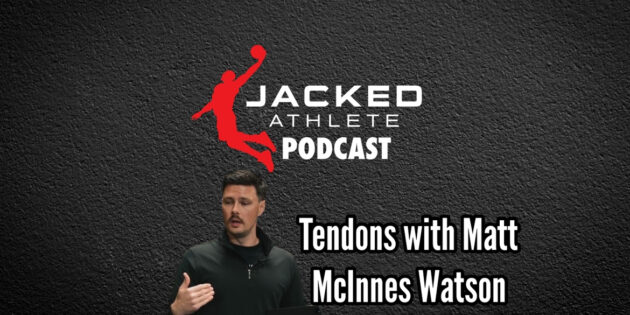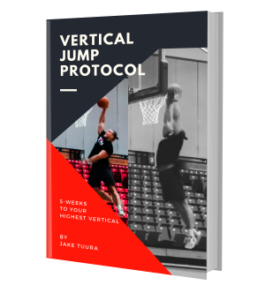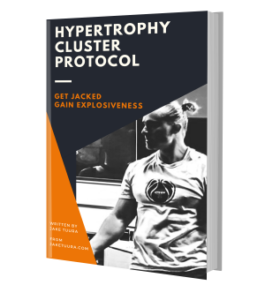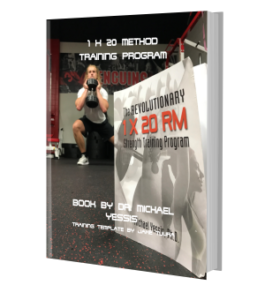https://podcasts.apple.com/us/podcast/jacked-athlete-podcast/id1462537296?i=1000692571884
“Obviously there’s a learning component. You’re gonna learn and you’re gonna use the easy stuff first and that’s how you’re gonna learn the movement patterns and then you’re just gonna scale things up.”
“Once you back off of it for more than 10 days, you’re going to lose the neuromuscular output in that movement, whether it’s the firing rate, whether it’s an actual physiological tissue thing. There is something lost there I think and people know about it straight away and you just get that basic feedback but yeah I try to keep everything in there year long and just undulate what I need to at certain times.”
“The track and field world is weird. It’s like, unless you’re like 90 % healthy, you’re not going to be doing your event. You’re not going to be doing anywhere near to close to what you would do in competition. But like you say, in a team sport, can, like maybe I can just work on just shooting. I’m just doing pull-up jumpers today. I’m not driving to the basket. There’s no hard cuts in and out.”
“I wonder if there is such a high quality, coordinated capacity from someone that’s done a lot of volume of it, that they can get away from destroying themselves structurally a lot more than someone that is like the ape that just hammers the nail.”
“Eric spoke a lot about this. He would say, right, we’re to do this tier and it’s going to work a lot more on the structural side of development. And this tier is going to develop more of the neuromuscular output. And he always spoke to the medium tier being the structural development side of things.”
“No one is changing the structure by doing intensive plyos because number one, you don’t have the capacity to do the volume to achieve structural changes.”
“Structural change is in volume, it’s in continuous, maybe it’s long belts of bounding or high reps of bilateral movements on the spot. But I think that there’s a threshold as well, because there’s a lot of real light like pogo-esque like I’m just gonna bounce on the spot a bit and assume that I’m just gonna get some adaptation change which I genuinely don’t believe that that’s doing anything so you have to find this sweet spot of being like this is intense but I can turn it down like 10 % and still make it look as as if I’m doing pretty intense movements but I can do a lot higher volume and I can chill at that.”
“So light tier for me is I wouldn’t necessarily say that it is much more than maybe muscular side of the MTU development. Like maybe a greater ability to say it does go back to the neuromuscular side of things. So maybe like actual structural, maybe it doesn’t do that much. The medium tier for me is potentially where we might see change.”
Light tier: “Yeah, like for me it’s a learning environment and it’s a preparation environment for what’s to come. I’ll use basketball for example. They have a huge history of rolled ankles. So I just build a ton of different multi-directional light tear movements like five or six movements start that session after they’ve done like a bit of a warm up. Let’s just move in different directions and just get you confident proprioceptively. I’m not going to be throwing you like into real intense forms of plyos and multi-directions, but I’m going to just get the brain work in so that you can learn how to, you know, anticipate to contract at the right time, to stiffen at the right time.”
“You can have stiffness at both ends of the spectrum, but I think the conversation moves away from like stiffness of the properties of the tissue and stiffness from a neuromuscular point of view. So it’s like you’ve got joint stiffness and you’ve got tissue stiffness and everyone talks about the tissue stiffness, but never talks about the joint stiffness. So you can’t have one without the other.”
“I just feel like our bodies prefer that kind of movement. We live on that rhythmical kind of… Once you get moving and you’re just like taking off one after the other, you’re like, oh, this is starting to feel really good. Is it neuromuscular? Maybe. Is there also something happening? Like we’ve talked about with the IFM, the gels being able to self lubricate and continue to allow the tendon to glide a little bit better, there could be something there as well.”
“I looked at 1400 papers and 700 of them use plyometrics. But the ones that had the most significant changes in highly neuromuscular activities were genuinely the ones with the highest volume.”
Medium tier: “I think that there’s enough strain, and think there’s enough strain repetitively to actually stretch the thing. Whereas in the light-pogo stuff, I think it’s so muscly based. And it’s a funny thing to say, is a lot of people do like light tier plyometrics or very light pogo movements and they’ll use like a much more four foot base landing and they won’t get much heel drop and I’m like does that tell us that maybe there isn’t that much stretch from the there isn’t enough force to take the tendon through a long range and actually you need something that takes you to a level where actually we do see big heel drop.”
“I’ve done like a 50 set of like Pogo Leaps on the spot and I just walk away with my calves feeling like they’re just absolutely pumped to shit. Like that is like the resounding thing that I come away with and residually there’s nothing that I think like, oh my Achilles feels sore today or like I’ve had real any response from the Achilles from doing that. Whereas like I could turn up the intensity like 10 % where I’m like, I’m actually trying to hit the ground now straight away I think it shows they would definitely be like a steep curve when it comes to that like in terms of like volume and intensity and how they work there’s like a certain threshold that you can do a shit ton of volume at but as soon as you turn the intensity out that really really changes and I think it’s because of what’s actually happening globally rather than it being just more isolated to the muscles doing the work.”
“The volume is unlimited based on your calf capacity. I genuinely think that.”
“If I was to speculate that there is 100 % in my speculation, there has to be evidence that single leg, especially in just a hopping action or just using one leg, there has to be a higher level of tendon strain. Let’s say you’re using the Achilles as an example. There is far less supportive muscles and structures that can help on a single limb that’s continually being used in comparison to a double structure that lands. You can hide so much more in two foot movement than you can on one leg.”
“As soon as you lengthen things out, it’s just going to become more muscular. So when you’re driving down a road and you can see someone that is, they’re not a runner, they’re a plodder, and they are spending like half a second on the floor. There is no way, and you can see that the deflection that they’re in at the hip and the knee, this person is paddling along the street. I just don’t believe that the changes to tendons can really take place there because it’s just far too long in terms of like the muscles, the muscles not going to pull and pull and pull and pull on that tendon for half a second and they go cool, now I can let go of you. The tendons far too stiff to allow that to go through that strain, I think. So it’s just going to dump it onto the muscle. And that’s why you see like the overuse.”
The plodders: “I think the overuse injuries then if you do have something like an Achilles tendonitis potentially becomes from you murdering your calves all the time and then doing something that is slightly too intense or doing something that, I’ve done a different kind of workout, I’ve ran some hills. I think those sort of spikes are massively apparent.”
“If you were to compare the differences between a world-class Ethiopian distance run, and then you look at someone that is plodding along the street and runs 15 minute miles, they are at such deeper angles at the joints. And there’s just no way that the body’s gonna allow that to be tendon strain. There’s just gonna be so much more extensibility to the muscle.”
“You need to bounce on tendons for, let’s say, for a 10K, let’s 9,600 meters, and then you can go to metabolic, like muscular pushes for the last 400 meters. You can’t do the opposite. You can’t pull on a tendon when you’ve pushed with your calves and plotted with your calves for 9,600 meters and then expect to pull on a tendon at that point.”
“I think there is something to be said with the ability to allow your tendon to be more compliant. Like you say, the IFM allowing some gliding and movement and like so many, like I have no scientific evidence on any of the deep tear movements. If you can find stuff, great, but it’s like, there’s nothing, there’s absolutely nothing. But anecdotally, so many people that I work with have just said that it just feels like it greases and grooves the joint. Like it could just be a fucking blood flow thing. Because you get into a deep range and you just oscillate into something like that, it pumps the shit out of your quads and your glutes. But also, is there a secondary element to helping the tendon? There could be.”
“So you can do a lot of deep tear movements where you get a lot of positive shin angle. And again, anecdotally, when people were telling me that their Achilles is really pissed off, I’m like, cool, let’s not do tons of the stiff, fast stuff. We’ll do some deep tear stuff so I can still get landings in you. And they tell me how much more therapeutic that is for taking the, it’s just, it’s less force. It’s taking the system, the lower leg, through a range of motion at a slower speed that’s far more therapeutic and we can do high volume of it.”
“That’s what’s fucked about neuromuscular capabilities and the structural capability is your outputs will always be pretty high if you’ve had like, if you’ve had like 10 years of good training and then you do nothing for five years, your outputs will still be really high, but your structures will be absolutely dog shit.”
“I think there’s gotta be like two major development periods. Number one is peak height velocity when they’re growing the most in a certain amount of time. That’s gotta be a big one because obviously post that you have such a different structural change with regards to like how much that kiddies had to grow in that period of time just to match the bones.”
“And when I think about it, it makes sense with regards to structural change. I don’t know the chemical interaction with regards to like male, like testosterone versus what happens estrogen wise with regards to tendon growth. But I get the vibe that men tend to be a lot better with output because of those chemicals.”
Tendons over the age of 20: “I think you’re dealing with ropes, you’re not dealing with bands at this point. And I don’t, yeah, I think that kids are genuinely, they’re just so elastic that it’s more, the muscle of the tendon are almost like one rather than they are those separate entities.”
Matt’s website: https://www.plusplyos.com
Matt’s instagram: https://www.instagram.com/mcinneswatson/?hl=en



